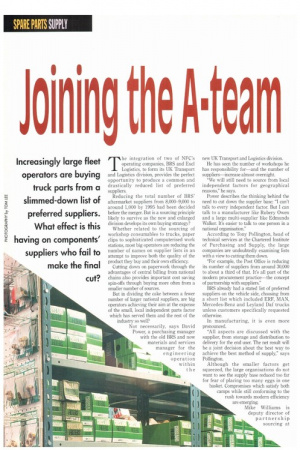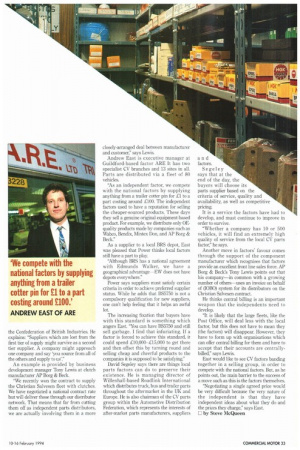i0111 1 1119 the
Page 34

Page 35

If you've noticed an error in this article please click here to report it so we can fix it.
Increasingly large fleet operators are buying truck parts from a slimmed-down list of preferred suppliers. What effect is this having on components' suppliers who fail to make the final cut?
The integration of two of NFC's operating companies, BRS and Exel Logistics, to form its UK Transport and Logistics division, provides the perfect opportunity to produce a common and drastically reduced list of preferred suppliers.
Reducing the total number of BRS' aftermarket suppliers from 8,000-9,000 to around 1,000 by 1995 had been decided before the merger. But is a sourcing principle likely to survive as the new and enlarged division develops its own buying strategy?
Whether related to the sourcing of workshop consumables to trucks, paper clips to sophisticated computerised work stations, most big operators are reducing the number of names on supplier lists in an attempt to improve both the quality of the product they buy and their own efficiency.
Cutting down on paperwork through the advantages of central billing from national chains also provides important cost saving spin-offs through buying more often from a smaller number of sources.
But in dividing the cake between a fewer number of larger national suppliers, are big operators achieving their aim at the expense of the small, local independent parts factor which has served them and the rest of the industry so well?
Not necessarily, says David Power, a purchasing manager with the old BRS and now materials and services manager for the engineering operation within the new UK Transport and Logistics division.
He has seen the number of workshops he has responsibility for—and the number of suppliers—increase almost overnight.
"We will still need to source from local independent factors for geographical reasons," he says.
Power describes the thinking behind the need to cut down the supplier base: "I can't talk to every independent factor. But I can talk to a manufacturer like Rubery Owen and a large multi-supplier like Edmunds Walker. It's easier to talk to one person in a national organisation" According to Tony Pollington, head of technical services at the Chartered Institute of Purchasing and Supply, the large companies are undoubtedly examining lists with a view to cutting them down.
"For example, the Post Office is reducing its number of suppliers from around 30,000 to about a third of that. It's all part of the modern procurement practice—the concept of partnership with suppliers."
BRS already had a stated list of preferred suppliers on the vehicle side, choosing from a short list which included ERF, MAN, Mercedes-Benz and Leyland Daf trucks unless customers specifically requested otherwise.
In manufacturing, it is even more pronounced.
"All aspects are discussed with the supplier, from storage and distribution to delivery for the end user. The net result will be a joint decision about the best way to achieve the best method of supply," says Pollington.
Although the smaller factors get squeezed, the large organisations do not want to see the supply base reduced too far for fear of placing too many eggs in one basket. Compromises which satisfy both camps while still conforming to the rush towards modern efficiency are emerging.
Mike Williams is deputy director of partnership sourcing at the Confederation of British Industries. He explains: "Suppliers which are lost from the first tier of supply might survive as a second tier supplier. A company might approach one company and say 'you source from all of the others and supply to us'."
An example is provided by business development manager Tony Lewis at clutch manufacturer AP Borg & Beck.
"We recently won the contract to supply the Christian Salvesen fleet with clutches. We have negotiated a national contract rate but will deliver those through our distributor network, That means that far from cutting them off as independent parts distributors, we are actually involving them in a more closely-arranged deal between manufacturer and customer," says Lewis.
Andrew East is executive manager at Guildford-based factor ARE It has two specialist CV branches and 13 sites in all. Parts are distributed via a fleet of 80 vehicles.
"As an independent factor, we compete with the national factors by supplying anything from a trailer cotter pin for ,E1 to a part costing around £100. The independent factors used to have a reputation for selling the cheaper-sourced products. These days they sell a genuine original equipment-based product. For example, we distribute only OEquality products made by companies such as Wabco, Bendix, Mintex Don, and AP Borg & Beck."
As a supplier to a local BRS depot, East was pleased that Power thinks local factors still have a part to play.
"Although BRS has a national agreement with Edmunds Walker, we have a geographical advantage —EW does not have depots everywhere."
Power says suppliers must satisfy certain criteria in order to achieve preferred supplier status. While he adds that BS5750 is not a compulsory qualification for new suppliers, one can't help feeling that it helps an awful lot.
The increasing fixation that buyers have with this standard is something which angers East. "You can have BS5750 and still sell garbage. I find that infuriating. If a factor is forced to achieve this standard, it could spend 10,000-415,000 to get there and then offset this by turning round and selling cheap and cheerful products to the companies it is supposed to be satisfying."
David Segeiey says there are things local parts factors can do to preserve their existence. He is managing director of Willenhall-based Roadlink International which distributes truck, bus and trailer parts throughout the aftermarket in the UK and Europe. He is also chairman of the CV parts group within the Automotive Distribution Federation, which represents the interests of after-market parts manufacturers, suppliers and factors.
Segeley says that at the end of the day, the buyers will choose its parts supplier based on the criteria of service, quality and availability, as well as competitive pricing.
It is a service the factors have had to develop, and must continue to improve in order to survive.
"Whether a company has 10 or 500 vehicles, it will find an extremely high quality of service from the local CV parts factor," he says.
Another move in factors' favour comes through the support of the component manufacturer which recognises that factors provide an excellent front line sales force. AP Borg & Beck's Tony Lewis points out that his company—in common with a growing number of others—uses an invoice on behalf of (I0130) system for its distributors on the Christian Salvesen contract.
He thinks central billing is an important weapon that the independents need to develop.
"It is likely that the large fleets, like the Post Office, will deal less with the local factor, but this does not have to mean they (the factors) will disappear. However, they have to form up with organisations which can offer central billing for them and have to accept that their accounts are centrallybilled," says Lewis.
East would like to see CV factors banding together in a selling group, in order to compete with the national factors. But, as he points out, the main barrier to the success of a move such as this is the factors themselves.
"Negotiating a single agreed price would be very difficult because the very nature of the independent is that they have independent ideas about what they do and the prices they charge," says East.
E by Steve McQueen




















































































